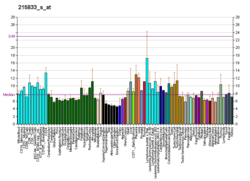SPPL2B
Signal peptide peptidase-like 2B, also known as SPPL2B, is a human gene.[5]
This gene is a member of the signal peptide peptidase-like protease (SPPL) family with the conserved active site motifs 'YD' and 'GxGD' in adjacent transmembrane domains (TMDs). This enzyme localizes to endosomes, lysosomes, and the plasma membrane. This protein plays a role in innate and adaptive immunity by cleaving TNFα in activated dendritic cells.[6][7] Multiple transcript variants encoding different isoforms have been found for this gene.[5]
References
- 1 2 3 GRCh38: Ensembl release 89: ENSG00000005206 - Ensembl, May 2017
- 1 2 3 GRCm38: Ensembl release 89: ENSMUSG00000035206 - Ensembl, May 2017
- ↑ "Human PubMed Reference:".
- ↑ "Mouse PubMed Reference:".
- 1 2 "Entrez Gene: SPPL2B signal peptide peptidase-like 2B".
- ↑ Friedmann E, Hauben E, Maylandt K, et al. (2006). "SPPL2a and SPPL2b promote intramembrane proteolysis of TNFalpha in activated dendritic cells to trigger IL-12 production". Nat. Cell Biol. 8 (8): 843–8. doi:10.1038/ncb1440. PMID 16829952.
- ↑ Fluhrer R, Grammer G, Israel L, et al. (2006). "A gamma-secretase-like intramembrane cleavage of TNFalpha by the GxGD aspartyl protease SPPL2b". Nat. Cell Biol. 8 (8): 894–6. doi:10.1038/ncb1450. PMID 16829951.
Further reading
- Bonaldo MF, Lennon G, Soares MB (1997). "Normalization and subtraction: two approaches to facilitate gene discovery". Genome Res. 6 (9): 791–806. doi:10.1101/gr.6.9.791. PMID 8889548.
- Nagase T, Kikuno R, Ishikawa K, et al. (2000). "Prediction of the coding sequences of unidentified human genes. XVII. The complete sequences of 100 new cDNA clones from brain which code for large proteins in vitro". DNA Res. 7 (2): 143–50. doi:10.1093/dnares/7.2.143. PMID 10819331.
- Weihofen A, Binns K, Lemberg MK, et al. (2002). "Identification of signal peptide peptidase, a presenilin-type aspartic protease". Science. 296 (5576): 2215–8. doi:10.1126/science.1070925. PMID 12077416.
- Grigorenko AP, Moliaka YK, Korovaitseva GI, Rogaev EI (2003). "Novel class of polytopic proteins with domains associated with putative protease activity". Biochemistry Mosc. 67 (7): 826–35. doi:10.1023/A:1016365227942. PMID 12139484.
- Strausberg RL, Feingold EA, Grouse LH, et al. (2003). "Generation and initial analysis of more than 15,000 full-length human and mouse cDNA sequences". Proc. Natl. Acad. Sci. U.S.A. 99 (26): 16899–903. doi:10.1073/pnas.242603899. PMC 139241. PMID 12477932.
- Grimwood J, Gordon LA, Olsen A, et al. (2004). "The DNA sequence and biology of human chromosome 19". Nature. 428 (6982): 529–35. doi:10.1038/nature02399. PMID 15057824.
- Friedmann E, Lemberg MK, Weihofen A, et al. (2005). "Consensus analysis of signal peptide peptidase and homologous human aspartic proteases reveals opposite topology of catalytic domains compared with presenilins". J. Biol. Chem. 279 (49): 50790–8. doi:10.1074/jbc.M407898200. PMID 15385547.
- Gerhard DS, Wagner L, Feingold EA, et al. (2004). "The status, quality, and expansion of the NIH full-length cDNA project: the Mammalian Gene Collection (MGC)". Genome Res. 14 (10B): 2121–7. doi:10.1101/gr.2596504. PMC 528928. PMID 15489334.
- Krawitz P, Haffner C, Fluhrer R, et al. (2006). "Differential localization and identification of a critical aspartate suggest non-redundant proteolytic functions of the presenilin homologues SPPL2b and SPPL3". J. Biol. Chem. 280 (47): 39515–23. doi:10.1074/jbc.M501645200. PMID 15998642.
- Fluhrer R, Grammer G, Israel L, et al. (2006). "A gamma-secretase-like intramembrane cleavage of TNFalpha by the GxGD aspartyl protease SPPL2b". Nat. Cell Biol. 8 (8): 894–6. doi:10.1038/ncb1450. PMID 16829951.
- Friedmann E, Hauben E, Maylandt K, et al. (2006). "SPPL2a and SPPL2b promote intramembrane proteolysis of TNFalpha in activated dendritic cells to trigger IL-12 production". Nat. Cell Biol. 8 (8): 843–8. doi:10.1038/ncb1440. PMID 16829952.
This article is issued from
Wikipedia.
The text is licensed under Creative Commons - Attribution - Sharealike.
Additional terms may apply for the media files.





